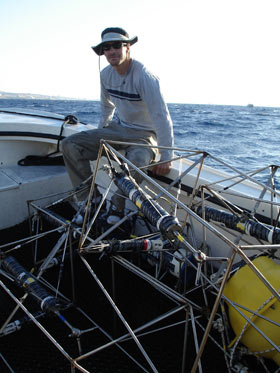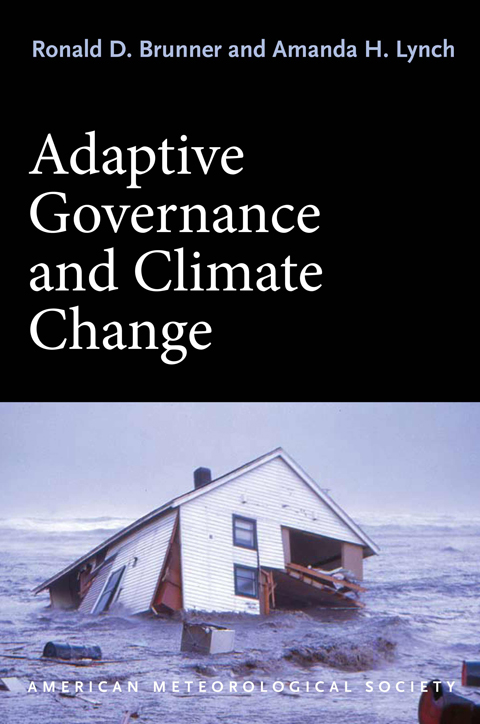by William Hooke, AMS Policy Program Director. From the AMS project, Living on the Real World
“Facts are stubborn things, but statistics are more pliable.”
– Mark Twain
When I was a graduate student in physics at The University of Chicago, the department had a weekly seminar. One year Subrahmanyan Chandrasekhar, a faculty member, already a famous astrophysicist (he would go on to win the Nobel prize) and author of over 1000 publications, delivered a talk on his new theory of quasars. The next week’s speaker happened to be Tommy Gold, a Brit, a fellow of the Royal Society, and then on the faculty at Cornell. He laid out a competing theory. When Gold was done, Chandrasekhar was the first person to ask a question. Wearing his signature pinstripe suit and looking like he just stepped out of the pages of GQ, Chandrasekhar cut a dignified figure as he rose from his chair. “Surely you would agree…” he smoothly began…
Can’t remember exactly what he said next, but it was the equivalent of asking Gold whether he believed that 2+2=4. It was also the first step down a line of argument that would lead to Chandrasekhar’s theory. The room was packed, but you could have heard a pin drop. Gold looked at him for what seemed like forever; then finally said “No.”
Maybe for the more senior faculty this was just another day at the lab, but we students had never seen a scientist do that. Every person in the room knew the only right answer was “yes.” Most of us had also been present the week before. Chandrasekhar glowered, then silently took his seat. A serious chill set in the room. The Q&A went on for some time, but never fully recovered.
Tommy Gold knew that you couldn’t separate data and facts from considerations of the end. To defend his theory he was going to have to say “no” at some point, so he might as well do it early.
It was not science’s best day. But in that instant I took to heart – internalized in my gut, not just my head – that while science might be objective, the pursuit of science could be very political – and combative. As a result, the process of collecting and analyzing the data can’t really be separated from considerations of the end use.
I got to see this up close and personal from 1987-1993 . At that time I was the NOAA Deputy Chief Scientist. The National Acid Precipitation Assessment Program (NAPAP) Program, an interagency group, was administratively housed in NOAA under the leadership of the Chief Scientist. The same argument was playing out, but now
policy studies
No One of Us Can Solve the Whole Problem
by William Hooke, AMS Policy Program Director, from the AMS Project, Living on the Real World
“Go to the ant, you sluggard; consider its ways and be wise!”
This Biblical proverb warns against laziness, and exhorts each of us to higher levels of diligence and industry. A good idea! However, there’s more here. The ant also demonstrates the power of effective policy. Before turning to the ant, a brief segue…
Have you ever watched a flock of birds? (Or, equivalently, a school of fish?) Scientists are getting clever about why birds (and fish) exhibit such behavior. The motives are apparently social and include protecting against predators, staying warm in winter, and sorting out dominance. But how do they do it, given that they’re under the control of birdbrains? We don’t know for sure, but here you will find a video of “boids”: what flocking would look like if birds operated on the basis of three rules:
- matching speed and direction with nearby birds
- maintaining a minimum separation, to avoid in-flight collisions, and
- always flying toward the center of the flock
The rules seem pretty simple, don’t they? Reading them, it’s pretty easy to imagine that birds are able to operate, and cooperate, on this basis. And sure enough, the video looks pretty realistic, doesn’t it? In essence, flocking birds seem to have a policy, a framework for making decisions. By the way – and this is important to tuck away for later – this kind of behavior is called “emergent.” If you study a few birds in the laboratory, you would never know about this ability. It’s only when birds are present in large numbers, and free to behave as they want, that this behavior emerges. If you’ve got the time (six minutes), check out this YouTube video: starlings on Otmoor to see flocking in its fullest grandeur:
But back to the ants. Though birdbrains are the subject of ridicule, birds are mental giants compared with insects. And ants exhibit their own emergent behavior, don’t they? Again, study
A Dose of Reality: The Social Side of Disasters
by William Hooke, AMS Policy Program Director,
from the AMS Project, Living on the Real World
Reality: Disasters – that is, disruptions of entire communities, persisting after an extreme has come and gone, and exceeding a community’s ability to recover on its own – are largely a social construct. Consider this simple example. Meteorologists call a tropical storm a hurricane when its winds exceed some 75 miles per hour. The strongest hurricanes ever observed show wind speeds about twice this level, 150 mph, say. Physics tells us that the forces on buildings and structures should vary as the square of the wind speed (getting a little technical …). The strongest hurricanes therefore pack a wallop about four times that of the weakest; the area suffering hurricane-force winds also tends to be a bit bigger. But the damages from these largest storms may be 200 times as great. One contributor to this big difference? Building codes. These are county-based, and so vary somewhat across the 3000-some counties in the United States, but in hurricane-prone areas usually require that brick-and-mortar residential construction withstand wind speeds of about 120 mph – right in the middle of the hurricane-force wind range. [Manufactured housing, by contrast, is governed by a less-rigorous federal standard, which requires that such structures only maintain their integrity at wind speeds up to some 70-90 mph.] Change building codes, and you change this loss profile.
Alert! These are our choices, but they’re not necessarily bad choices. When it comes to building codes, we’re simply forced to set a realistic standard. Whenever we wish, we can elect to build homes that will withstand hurricane-force winds, or even the strongest tornadic winds, which might approach 300 mph. But these homes would be considerably more expensive. They might be built largely underground, looking more like World War II “pillboxes” than homes, with narrow slits for windows, etc. Remember, they have to bear up not just to the winds but also to the windborne debris: lumber, roofing, automobiles, etc. Most of us wouldn’t be able to afford them, and wouldn’t want to live in them even if we could. We prefer our views, the connection with the outdoors. So we build a safe room, or a storm cellar, and accept the remaining risk.
Building codes are but one example; here’s another – land use. Simply by choosing to build in the flood plain alongside rivers and on the coasts, we ensure that our future will be punctuated by repetitive loss. Build on an earthquake fault-line? Expect the same outcome. There’s much more to this topic. We’ll return to it down the road.
But, for now, let’s set it aside in order to introduce a more complicated notion. When we choose to urbanize – and over half the world’s population lives in cities now – we expose ourselves to other risks, and different kinds of risk at that. To live in cities requires critical infrastructure, ranging from the elevators that service high-rise buildings to networks of roads, sewage systems, water works, electrical grids, communications, financial services, health care, and so on. As a result, we’re now subject to outages of these systems, from whatever cause. An example from the Midwest flooding of 1993. The city of Des Moines, Iowa remained largely dry; only a small sliver of land
AMS Climate Briefing to Examine Health Issues
A search for the word “health” in the AMS Annual Meeting conference program brings up more than 180 hits, highlighting the current interest in understanding climate’s effects on human health (and the best ways to mitigate these effects). Tomorrow’s (February 5) AMS Climate Briefing in Washington, D.C., will address these issues with the help of three public health experts:

Dr. Rita Colwell of the University of Maryland and the Johns Hopkins School of Public Health will talk about the connection between environmental change (such as heat waves and hydrologic extremes) and disease risk, with a focus on infectious diseases, including both vector-borne (e.g., malaria, plague, and many viral diseases) and water-borne diseases (e.g., cholera). She will also discuss other effects such as mental health problems and civil disruption.

Dr. Howard Frumkin of the CDC will look at the framework for public health response to environmental threats that was developed at the CDC. Now being implemented at the federal, state, and local levels, the response involves such longstanding core public health activities as disease surveillance, outbreak investigations, vulnerability assessments, health communication, and preparedness planning. Additionally, he will highlight the importance of assessing the health consequences of mitigation strategies so that decision-makers can choose the most health-protective approaches.

Dr. Jonathan Patz of the University of Wisconsin will explain the innovative strategy known as co-benefits, which promotes improved health while also mitigating climate change. For example, certain transportation strategies both limit travel demands and encourage walking and/or bicycling, thereby promoting positive health effects (such as reduced risk of cardiovascular disease, cancer, and asthma) as well as a cleaner environment. Dr. Patz will discuss recent U.S. studies suggesting that climate change mitigation could offer a substantial opportunity to improve public health and save billions of dollars in healthcare costs and worker productivity.
The hour-and-a-half long briefing is given twice on Capitol Hill: at 11 a.m. in Room 210 of the Cannon House Office Building and at 2 p.m in Room 406 of the Dirksen Senate Office Building.
"An Incredible Experience"
The AMS/UCAR Congressional Science Fellowship is a unique opportunity for scientists to become involved in the policy process on Capitol Hill. On Tuesday, the current AMS fellow and two former fellows gathered to discuss some of their experiences and dispense advice to potential applicants.
The 2009-10 AMS Congressional Fellow is Jonah Steinbuck, who received his Ph.D. in environmental fluid mechanics and hydrology from Stanford University in 2009. Steinbuck describes his work as a fellow for Representative Edward Markey (D-MA) in the Select Committee for Energy Independence and Global Warming as an “incredible experience.”
Steinbuck noted that he chose working with Markey and the Select Committee for a number of reasons: 1) because of his interest in climate policy and his belief that the Select Committee gave him the best opportunity to pursue that interest, 2) because “Chairman Markey is one of the leaders in environmental and energy issues,” and 3) because of the Select Committee staff, which allows him to be “a sponge absorbing information” from “some of the best climate policy talent on Capitol Hill.”

Perhaps the highlight of Steinbuck’s fellowship thus far was his recent trip to the Copenhagen Summit, where he received a credential from the State Department and was able to attend the talks. Steinbuck was particularly impressed with the dramatic conclusion when President Obama negotiated the final text of the agreement with other world leaders.
While the Select Committee awaits the final results of the conference, Steinbuck is also currently tracking EPA regulation of greenhouse gases while monitoring a number of bills proposed to block such regulation from stationary sources.
Past fellows Stephanie Herring and Michael Morgan also spoke about their Congressional Fellowship experiences. Herring, who like Steinbuck served under Congressman Markey in the Select Committee for Energy Independence and Global Warming, is currently working on climate science and service issues as a climate policy analyst in the office of the Department of the Deputy Undersecretary at NOAA. During her time as a fellow, Herring worked on the original version of the legislation that eventually became the Clean Energy and Security Act (also known as the Waxman-Markey Bill). She called the fellowship an ideal transition into new pursuits and in this clip responded to a question on how her fellowship experience enhanced her Ph.D. studies.
Morgan, currently a professor at the University of Wisconsin, recalled his time in Senator Benjamin Cardin’s (D-MD) personal office with fondness, even though, as he explained here, it was the exact opposite of what he originally thought he was looking for in a fellowship experience. Morgan explained that one of the most important things he learned on Capitol Hill was that “science is not enough”–senators must consider all their legislative priorities and their constituents’ priorities and determine how science fits into that framework.
The speakers cited numerous characteristics that Congressional Fellowship applicants should have: analytic skills, interpersonal skills, awareness of federal policy, an understanding of the role and limits of science in federal policy, diplomacy and political acumen, a sense of ethics, and perhaps most importantly, a legitimate interest in policy that has been displayed in their academic career. They noted that the competition for the fellowship is considerable and that the scientific records of most applicants is outstanding.
Applications for the 2010-2011 fellowship are due by February 10.
Innovations in Climate Adaptation
UPDATE, 1/17/10: Due to a last-minute scheduling change, Amanda Lynch will be unable to attend the Annual Meeting. Adaptive Governance and Climate Change will still be a featured release at the AMS Book Launch Party on Monday.
The recent Copenhagen conference provided yet more evidence that countries with completely different priorities are often reluctant to enter into complex and costly agreements with each other. While international negotiations may seem cumbersome at best, some scholars argue that climate change may best be solved at the local–rather than international–level. Local action may not only be more effective but also could also someday might lead to international agreements.
This local-first policy approach will be explored in a variety of ways at the AMS Annual Meeting, headlined by the release of a new AMS book, Adaptive Governance and Climate Change, by Ronald Brunner and Amanda Lynch. Brunner and Lynch show how locally based programs foster the necessary diversity and innovation for climate adaptation.  Their book focuses on the real-life climate issues faced by Barrow, Alaska—and analyzes how the policies developed to address those issues could be adopted by other communities.
Their book focuses on the real-life climate issues faced by Barrow, Alaska—and analyzes how the policies developed to address those issues could be adopted by other communities.
In Atlanta, Lynch will be available to discuss these policy perspectives when the book is released as part of the AMS Book Launch Party (Monday, 5:30 p.m., exhibit hall B1, booth 146). In addition, she will be signing copies of the book on Monday and Wednesday (2:45–4:00 p.m., exhibit hall B2).
Communities across the world are moving toward adaptive governance, as can be seen in a number of presentations at the Annual Meeting. Nanteza Jamiat’s poster on “Adaptation Challenges to Climate Change Disasters in the Karamoja Cluster (Cattle Corridor) in Uganda” (at the student poster session, Sunday, 5:30–7:00 p.m., exhibit hall B2) addresses the interrelationship of climate change and agriculture in a country where both are a way of life for most of the population. Barry Smit’s presentation on “Traditional Knowledge and Adaptation to Climate Change in the Canadian Arctic” (Wednesday, 9:00–9:15 a.m, B213) focuses on indigenous people in the Arctic and the cultural barriers that sometimes need to be broken in order to implement local adaptation initiatives. The Pacific Island nation of Tuvalu is the subject of “Weathering the Waves: Climate Change, Politics, and Vulnerability in Tuvalu,” a poster by Heather Lazrus (Monday, 2:30–4:00 p.m., exhibit hall B2) that shows how one of the most vulnerable areas in the world is in some cases reverting to traditional governmental methods to meet the perils of climate change. And Cynthia Fowler’s presentation on “Coping in Kodi: Local Knowledge about and Responses to Climate Change and Variable Weather on Sumba (Eastern Indonesia)” (Tuesday, 4:15-4:30 p.m., B213) notes that many people in Indonesia’s marginal environments relate climate change to local development, thus crystallizing in one small area many of the problems that were evident at Copenhagen between developing and developed countries.